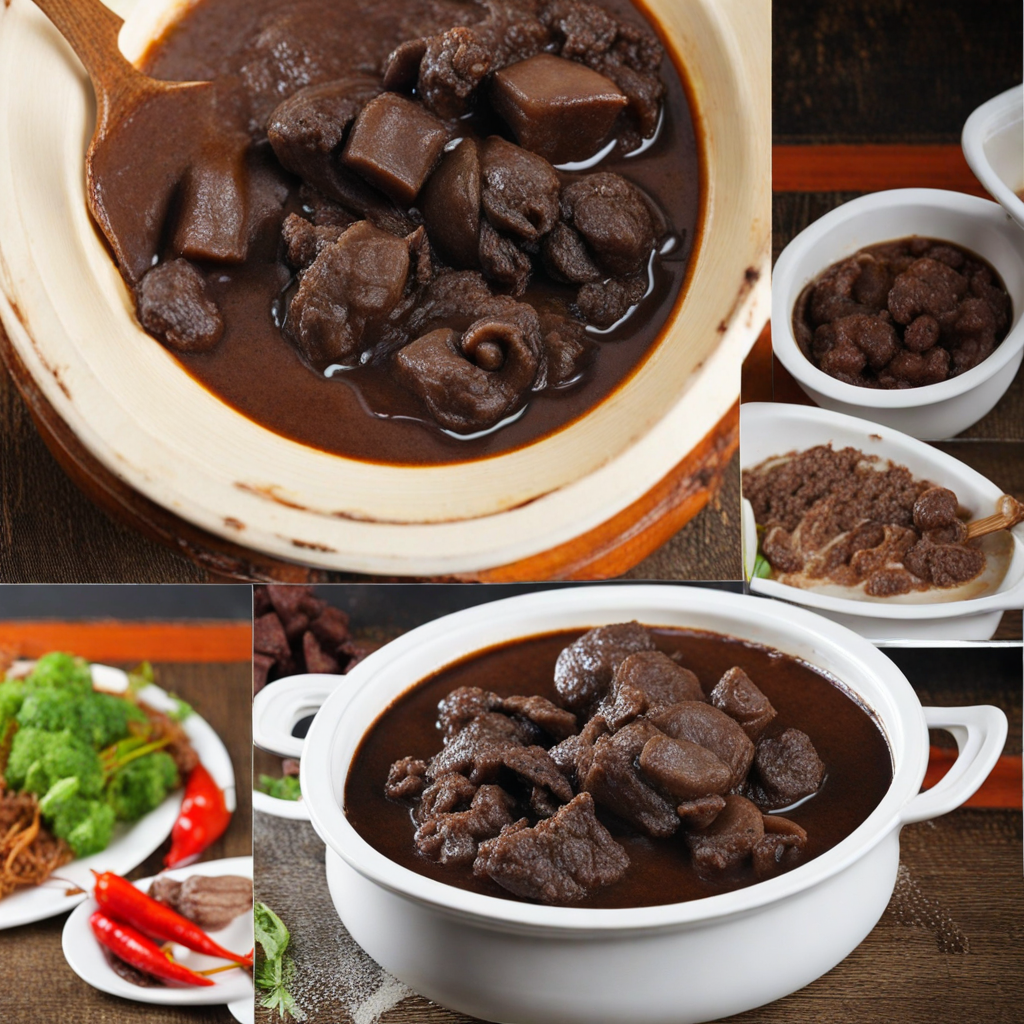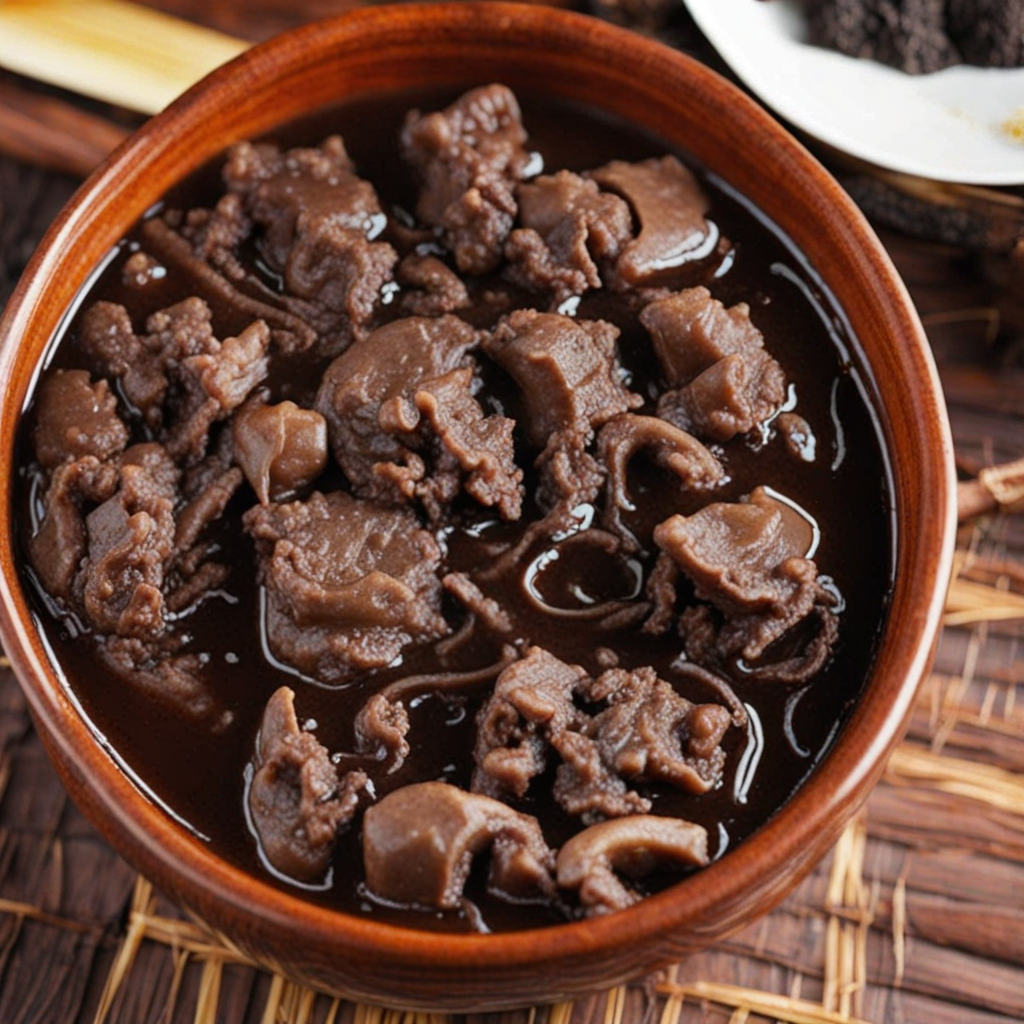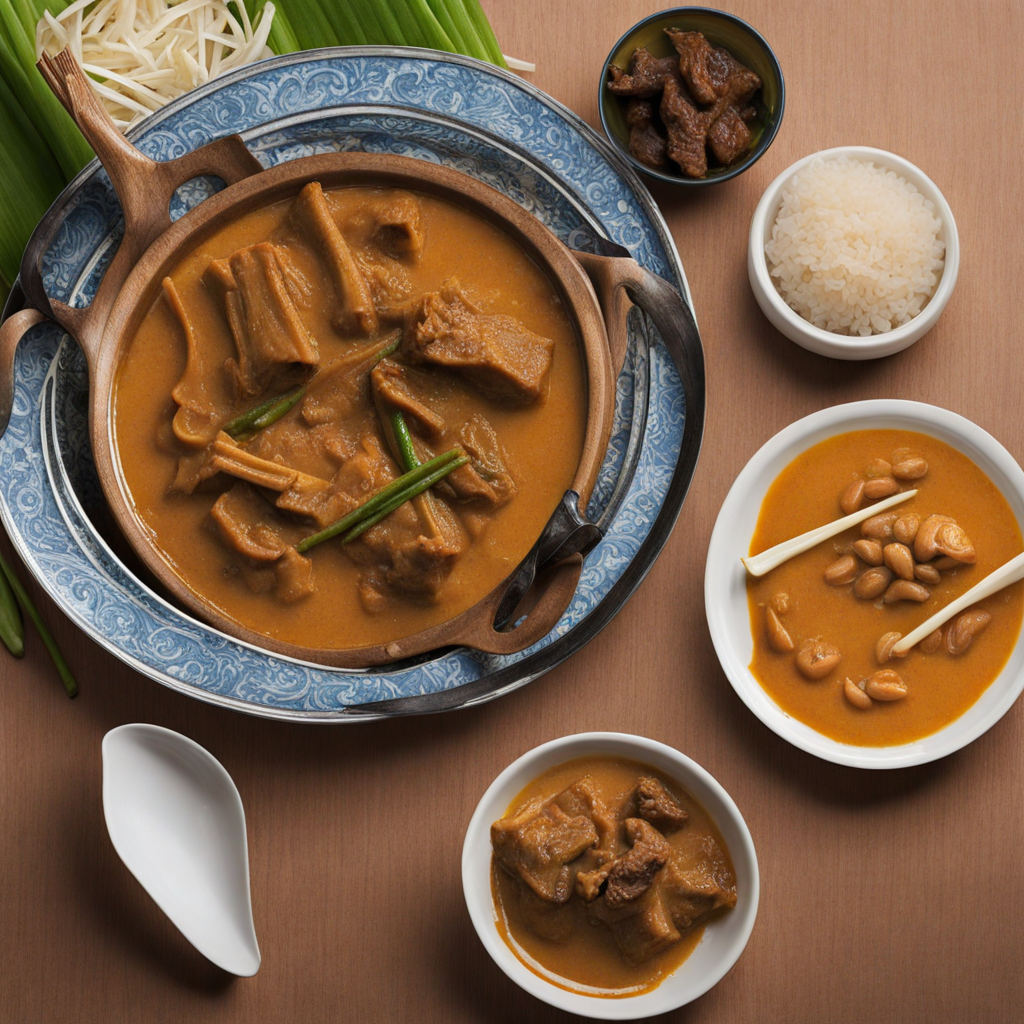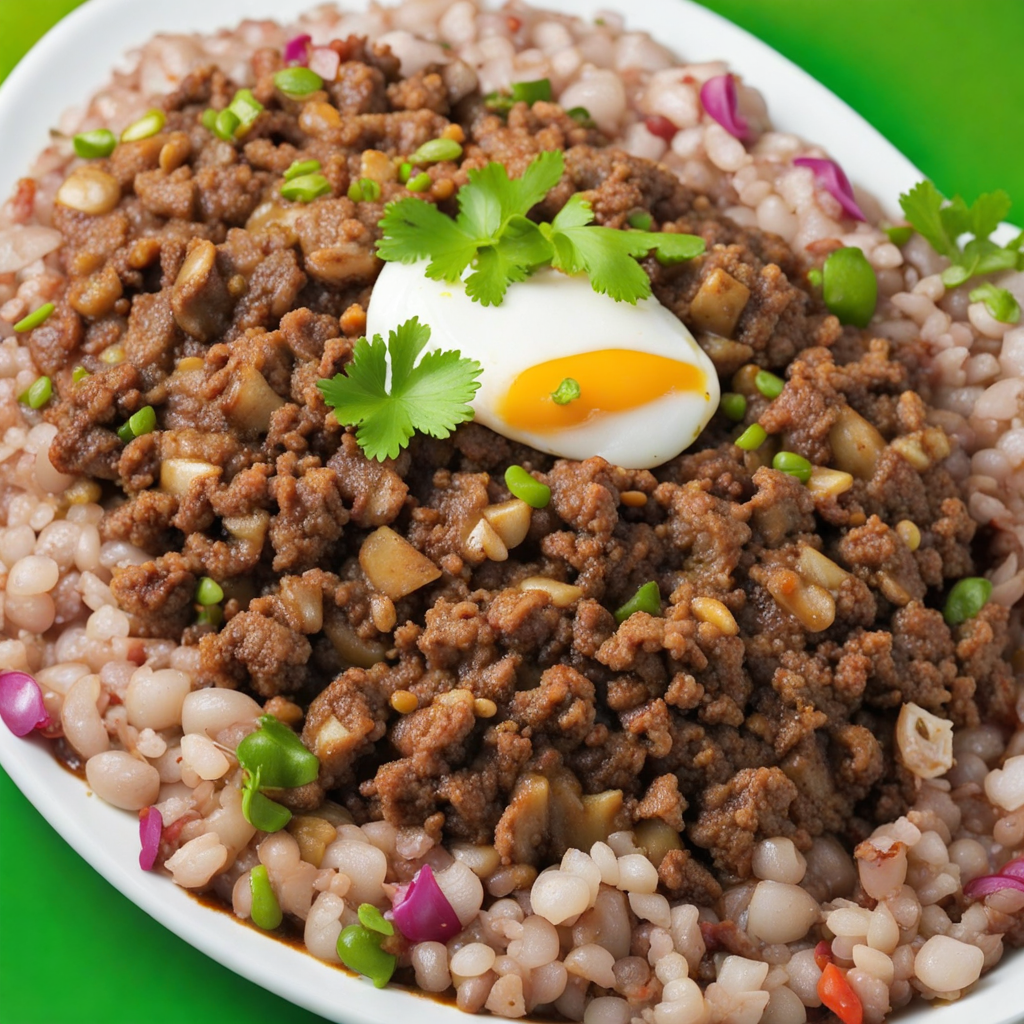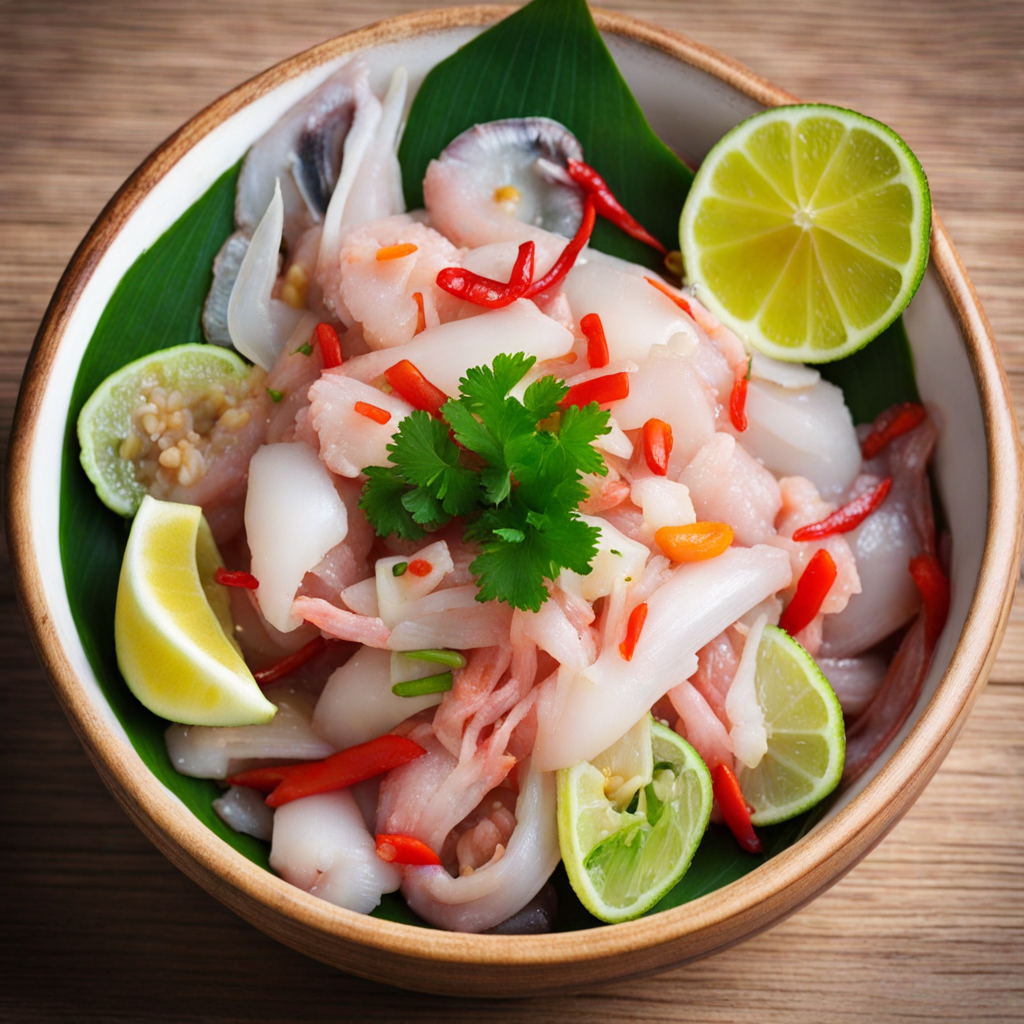Dinuguan
Dinuguan is a traditional Filipino dish that offers a unique and bold flavor profile, making it a must-try for adventurous eaters. Often referred to as "blood stew," this savory dish is made primarily from pork, traditionally using cuts like the belly or shoulder, which are slow-cooked to tender perfection. The meat is simmered in a rich, dark sauce that is primarily composed of pig's blood, vinegar, garlic, and a blend of spices, resulting in a complex flavor that balances the salty and tangy elements beautifully. The dish is typically served hot, allowing diners to fully appreciate the depth of its flavors. The texture of Dinuguan is another highlight of this dish. As the pork cooks down, it becomes incredibly tender, while the sauce thickens to a glossy, luscious consistency that clings to the meat. The addition of chili peppers can give it a slight kick, enhancing the overall experience. Dinuguan is often accompanied by steamed rice or puto, which are Filipino rice cakes, providing a neutral base that perfectly complements the rich and hearty stew. The combination creates a satisfying meal that is both comforting and invigorating. Dinuguan is not just a dish; it is a cultural experience that reflects the Filipino spirit of resourcefulness and communal dining. Often enjoyed during special occasions and gatherings, this dish invites people to come together and savor its distinctive taste. For those willing to step outside of their culinary comfort zones, Dinuguan promises an unforgettable experience that showcases the vibrant flavors of Filipino cuisine, making it a dish worth seeking out.
How It Became This Dish
Dinuguan: A Savory Legacy of the Philippines #### Origins Dinuguan, often referred to as "chocolate meat," is a traditional Filipino dish that embodies the rich tapestry of the country's culinary heritage. Its primary ingredient is pork, typically offal, simmered in a thick sauce made from pig's blood, vinegar, and spices. The name "dinuguan" derives from the Filipino word "dugo," which means blood, highlighting its key ingredient. The origins of dinuguan are steeped in the agricultural practices of pre-colonial Philippines, where every part of the animal was utilized for sustenance. Early Filipino communities practiced a nose-to-tail philosophy long before it became a trend in modern gastronomy. Dinuguan was born out of necessity, a way to avoid waste and to make use of every part of the pig after a slaughter. This practice was not unique to the Philippines; many cultures around the world have similar dishes that celebrate offal, indicating a universal appreciation for resourcefulness in cooking. The dish's roots can also be traced back to the influence of Spanish colonization. The Spanish introduced various cooking techniques and ingredients that permeated Filipino cuisine, blending indigenous and foreign flavors. The use of vinegar in dinuguan connects it to the Spanish tradition of preserving food, while the incorporation of spices reflects the diverse agricultural landscape of the archipelago. #### Cultural Significance Dinuguan holds a special place in Filipino culture, often served during celebrations, family gatherings, and fiestas. It is more than just a dish; it represents a communal experience where families and friends come together to enjoy a meal. Traditionally, dinuguan is paired with puto, a steamed rice cake that balances the rich and savory flavors of the stew. The combination exemplifies the Filipino culinary ethos of harmonizing contrasting tastes and textures. In many regions of the Philippines, dinuguan is considered a comfort food, akin to the way stews are embraced in other cultures. It evokes nostalgia and is often prepared using family recipes passed down through generations, making it a vessel for familial love and tradition. Preparing dinuguan can also bring families together, as it often involves multiple hands in the kitchen, from butchering the meat to stirring the pot. Dinuguan also plays a role in local festivals and rituals. It is a dish that symbolizes abundance and gratitude, often prepared to honor patrons and deities. In some provinces, it is served during the feasts of local saints, reflecting the intertwining of culinary practices and spirituality in Filipino culture. #### Development Over Time As the Philippines underwent various sociopolitical changes, so too did dinuguan. The advent of globalization and the influence of modern culinary techniques have transformed how traditional dishes like dinuguan are perceived and prepared. In urban areas, the dish has been adapted to cater to contemporary palates, with some chefs experimenting with gourmet versions that incorporate fusion elements. One notable evolution of dinuguan is its presentation. While traditionally served in a bowl, modern interpretations often showcase the dish in a more stylized manner, emphasizing its visual appeal. Chefs have begun to plate dinuguan with artistic flair, often using microgreens or edible flowers to add a contemporary touch. This evolution speaks to the broader trend of elevating traditional dishes within the fine dining scene, allowing dinuguan to gain recognition both locally and internationally. Moreover, the rise of food tourism in the Philippines has led to an increased interest in traditional dishes, including dinuguan. Culinary enthusiasts, travelers, and local chefs have sought to highlight the dish's authenticity, promoting it as a must-try for anyone visiting the archipelago. This has also ignited a renewed appreciation among younger Filipinos for their culinary heritage, prompting them to explore and celebrate traditional recipes. The global Filipino diaspora has also played a significant role in the evolution of dinuguan. As Filipinos migrated to various parts of the world, they carried their culinary traditions with them. Dinuguan has found its way onto menus in Filipino restaurants abroad, captivating the palates of individuals unfamiliar with the dish. This has led to a cross-cultural exchange where dinuguan is not only enjoyed by Filipinos but also by food lovers from diverse backgrounds. However, the dish is not without controversies and misconceptions. The use of blood as a primary ingredient can be off-putting to some, leading to misunderstandings about its taste and preparation. Yet, those who embrace dinuguan often describe its flavor profile as rich, tangy, and deeply satisfying, a testament to the skillful balance of its ingredients. Moreover, the dish serves as a reminder of the importance of culinary diversity and the stories behind each ingredient. #### Conclusion Dinuguan is more than just a dish; it is a testament to the resilience and creativity of the Filipino people. Its origins reflect a deep-seated respect for resources while its cultural significance speaks to the communal bonds forged through food. Over the years, dinuguan has evolved, adapting to modern tastes while remaining rooted in tradition. As the world continues to embrace diverse culinary experiences, dinuguan stands out as a flavorful representation of the Philippines' rich heritage. In a world increasingly focused on sustainability and resourcefulness, dinuguan serves as a reminder of the importance of honoring tradition while embracing innovation. As it continues to captivate the hearts and palates of many, dinuguan remains a cherished symbol of Filipino identity, an enduring connection to the past, and an exciting prospect for the future of culinary exploration.
You may like
Discover local flavors from Philippines


